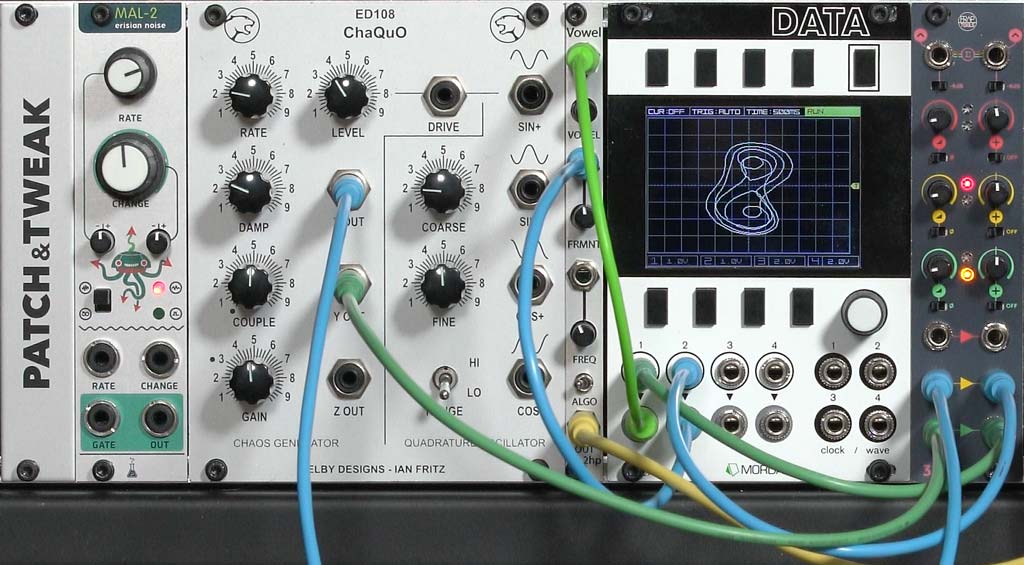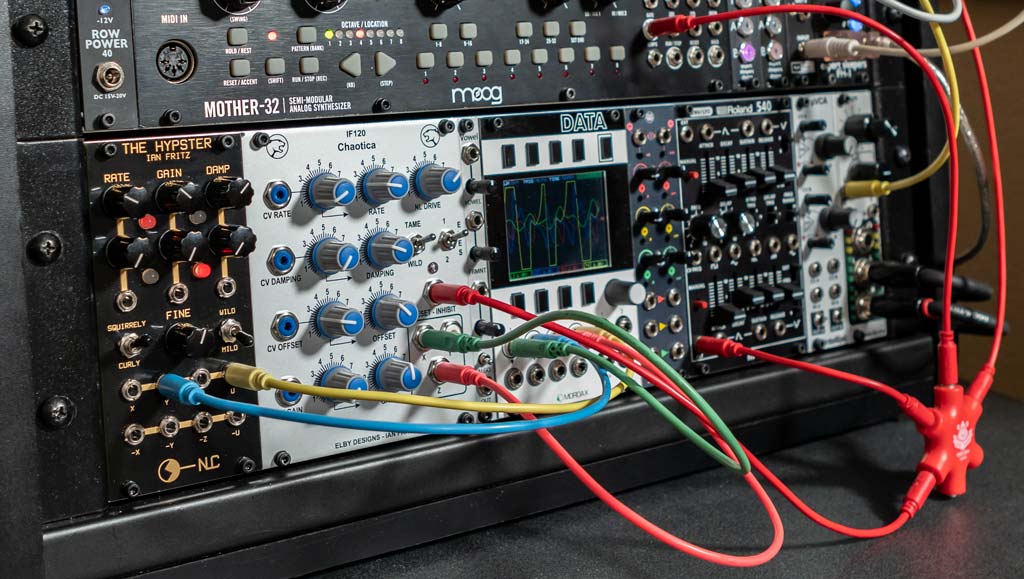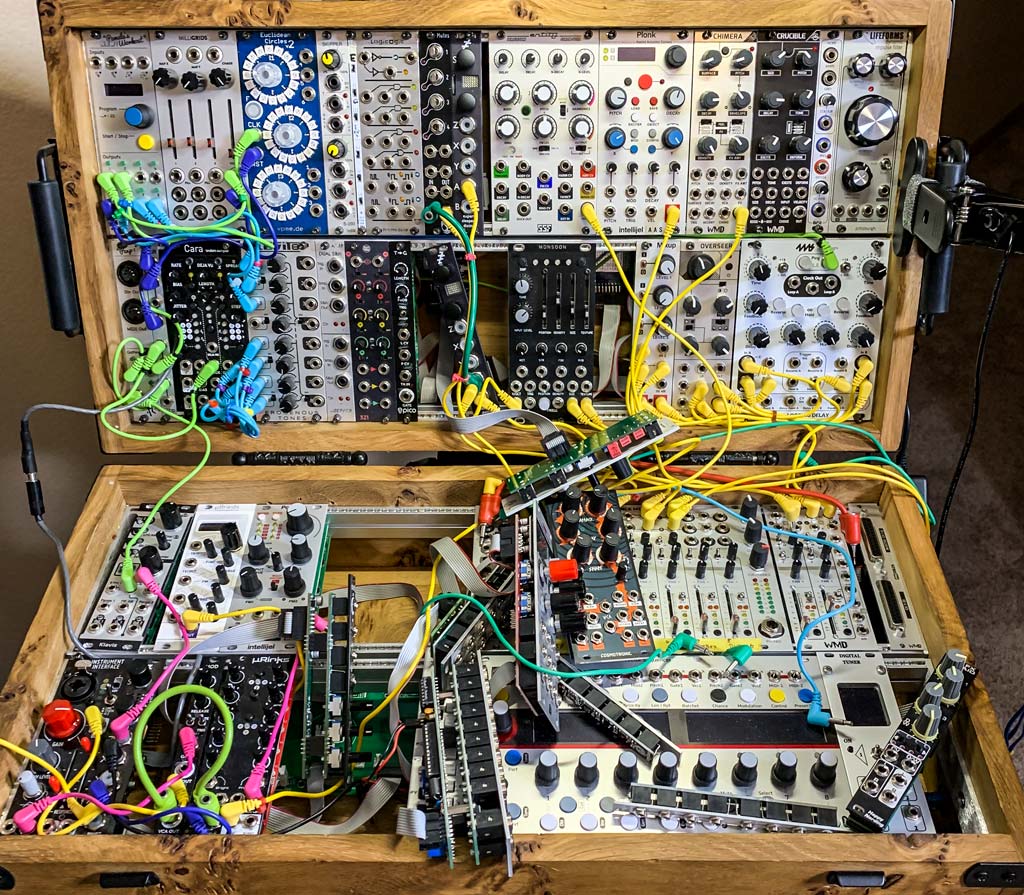Many of us are seeing our respective countries and states finally start to open up, cautiously, after being locked down to slow the spread of the coronavirus. That’s great news! But remember, the virus is still out there, and many who have spread it didn’t know they had it at the time. So if you feel safe, go ahead and start playing with others again, but remember to wear masks, and if you’re sharing any gear, wash your hands, and wipe down your patch cables, module knobs, or other shared surfaces both before and after. It’s a small hassle for getting to share this wonderful art with others.
Here is the index to this newsletter:
- featured article: on applying Chaos Theory to modulation sources
- new videos & posts: including the Patching the Monster live webcast
- course updates: including some updates on gear and what new courses I’m thinking about creating (please vote!)
- Patreon updates: including more details on the preparation for the Patching the Monster webcast, a musing on Acoustic Niche Theory, and more information on chaos
- upcoming events: including potential new webcasts on my portable gigging system
- one more thing: my brother – the person responsible for getting me into electronics, music, and video – is selling modular accessories, including Luigis Modular cables
Orderly Chaos
Reading James Gleick’s book Chaos Theory back in the late 1980s had a huge impact on me. Chaos is not the same as randomness; it exists somewhere between random and repeatability. A chaotic system stays within certain boundaries, and is usually attracted to certain positions or “states”, but its actual position and path within those boundaries can appear random.
Think of a moth flying around a light at night: Its path may seem random, but it tends to stay within a certain distance of that light. In this example, the light is known as a “strange attractor”: It behaves a bit like a magnet, but rather than things just flying toward it and sticking to it, instead objects tend to follow a wobbly orbit around it.
Using chaos theory is an excellent way to create an interesting modulation source. The result can seem to be “periodic” like a normal LFO for a given moment, but will evolve and create its own variations. After the core patch is together, this has become the thing I reach for when evolving a patch.
How chaos modules work
Many modules based on chaos theory use the classic “double well” model, where voltages tend to wobble around one of two different central values, flipping back and forth between those two centers. The image below shows two outputs of a double-well chaotic module (the Elby Designs version of Ian Fritz’s ChaQuO), plotted in XY space on a Mordax DATA. The result over time loosely follows a figure 8, as if our moth above had two lights to fly between. The two “eyes” of the 8 are the strange attractors or wells of this particular chaos model:

Other designs are more complex, allowing voltage control and having more outputs. They can be totally software-based (such as the Low Rents algorithm in Ornament & Crime), or use hardware. Ian Fritz in particular has been one of the leading lights in creating chaotic modulator circuits for modular synths. What is common to all of them is that are connected in a feedback loop in hardware, or use its equivalent (an iterative calculation) in software.
When a filter is wired in a feedback loop, it normally oscillates in a nice, clean, steady sine wave pattern. What makes a chaos circuit different is that it has a non-linear element – such as diodes or some other form of waveshaper – in that feedback loop, and perhaps even between the “poles of the filter” (hardware integrator sections, if you want to get technical). These non-linear elements are what bends the signal away from being a sine wave, and being wired in a feedback loop means the circuit (or code) keeps reacting to and building on the kinks thrown into the equation by those non-linear elements.
I recently created a video demonstrating the differences between periodic, chaotic, and random modulation sources:
I’ve also written a few articles recently on the subject:
- I wrote mini-reviews of three of Ian’s chaos module designs for Synth & Software; videos for each of these modules will follow in the not-too-distant future
- I also wrote a pair of posts for my Patreon subscribers, including a basic overview of periodic versus chaotic versus random (including patch suggestions), and a more in-depth post about how chaotic systems work
New Videos & Blog Posts
In addition to the Periodic vs. Chaotic vs. Random video plus the Synth & Software article on Ian Fritz’s chaos module designs mentioned above, during May Ben “DivKid” Wilson, Kim “Bjooks” Bjørn, and myself created the Patching the Monster webcast, where we woke up my Frankenstein of a studio modular synth and asked it to sing and dance:
The two main patch demos in that webcast were pre-recorded to make sure we could play them back with better quality. They are:
“KARP” – Korg Arpeggiator driving Rings and Pluck
In addition to contrasting the sounds of the 2hp Pluck and the Mutable Instruments Rings, this patch included a nice analog voice patch layering a birdkids TheBateleur VCO with a Livewire AFG. The filter built into TheBateleur was modulated with the velocity from the arpeggio, which gave it some extra “bounce” and character.
“G2R” – Grids to René
A distinctive feature of the Make Noise René sequencer is that it is laid out as a 4×4 grid, with separate clock inputs to move in the X and Y dimensions. Meanwhile, the Mutable Instruments Grids is a rhythm pattern generator that generates separate, complementary patterns sent to three outputs. What would happen if I used two of those outputs to separately clock the two dimensions of René? Something like this:
I’ve also recorded Welcome/About Me/Why Do I Do This? videos, and placed different versions of it on my YouTube and Patreon channels as well as my main and courses web sites.
Modular Courses Updates
Currently, I shoot 4k video for my courses, and output at 1280×720. When I use the full frame, you can see the entire system, but I can also crop down to just a single module so you can see the details of what I’m doing. Later this year, I’m going to upgrade to a 6k camera, so I can use the same techniques but now output at 1920×1080 so you can have even more resolution when trying to view small details. I’ll also probably move to DaVinci Resolve as my editing software when I do this. Lots to learn! But it will be worth it.
The plan was to do this upgrade before I started recording a new course on clocking and pattern generation tricks. But the response to the Patching the Monster webcast was so strong, that I’m thinking of creating a second course on general patching tricks. I’m curious to hear which you would prefer to see first; give me feedback in the Comments below.
Patreon Updates
As I’ve mentioned before, my Patreon supporters get the extended version/director’s cut of whatever I am working on or thinking. May was another busy month. For subscribers who have not had a chance to keep up with the recent posts, here’s what I was up to:
- All of the details of the KARP patch from the Patching the Monster webcast
- A deeper description of the Grids 2 René patch from Patching the Monster, including lots of alternate patch suggestions to play with these ideas using your own system
- An introductory-level post on using periodic versus chaotic versus random modulation sources, with some alternate patch ideas and application suggestions
- A much deeper dive into how chaos modulator circuits work, including a suggested patch you could try using common modules to create a chaotic feedback loop
- Tweaking the Monster: Details of all the changes I made to my Monster studio system (and why) between the Feeding the Monster series and the Patching the Monster webcast
- Modular Be-Bop and the Acoustic Niche Hypothesis: looking at how insects, birds, frogs, and animals have adapted in a given habitat to each be heard when they’re all singing or calling at once, with the suggestion this could be applied to electronic music composition
Upcoming Events
The response to the Feeding & Patching the Monster webcasts has been very positive. This has led several to ask that I do something similar for my portable gigging system. As it so happens, I’m in the process of upgrading its power and tweaking its module assortment – so Ben, Kim, and I have decided to do an episode or two based on it. This will hopefully happen before the end of June; I’m waiting on one more power supply part before work can move forward. Keep an eye on the Learning Modular Facebook page for updates.
One More Thing…
I wanted to slip in one more thing before I wrap up for the month: My older brother – Ronald (aka SquealyDan) – is the one responsible for getting me interested in music, electronics, and video. He is also the person behind Starving Students Music Supplies. Since he’s a saxophone player, It started as a way to sell odd-lot reeds and the such at attractive prices to other musicians. It’s grown since then to include many other products.
Although I swear I tried to talk him out of it (smile), he’s decided to expand into modular musician accessories. He’s started by buying out the leftover stock of Luigi’s Modular Supply cables, including their cool Doppio splitters, PAR right angle cables, Bucatini braided cables, and 3.5mm to 1/4” adaptor cables. We ran a poll on the Learning Modular Facebook page, and found many users wanted to buy bundle of cables that were the same color but of different lengths – an option others were not offering. So he re-bundled the cables he got into those groupings to sell. Those are currently available on Reverb.
He’s also going to start carrying some other accessories I’ve recommended, including lighted gloves for tweaking in the dark (!) – I’ve even made a video using them to control my Monster system in the dark. So check him out.
I hope you are all staying both healthy & inspired. It’s great to be involved in such an amazing creative field; thank you for including me on your journey.
warmest regards –
Chris







